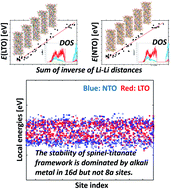How does the Li-distribution in the 16d sites determine the stability of A3(Li,Ti5)O12 (A = Li and Na)?†
Abstract
Li3(Li,Ti5)O12 (LTO) is a stable and safe negative electrode material for Li-ion batteries, and its Na substitute Na3(Li,Ti5)O12 (NTO) is a counterpart for the Na-ion battery. In LTO and NTO, a sixth of the Ti-sites (16d) in the spinel framework are replaced by Li: Li mixing in the 16d sites. For conducting theoretical studies on these materials, e.g., density functional theory (DFT) calculations, one has to confront the astronomical number of combinations of Li distribution in 16d sites to construct model structures, of which the size is sufficiently large to represent the bulk material properties. Only a limited number of models, whose structures are a priori specified by “researcher intuition,” have been examined thus far, and how Li-mixing determines the material stability has yet to be clarified. Herein, we statistically analyzed the DFT total energy of more than 2 × 104 model structures of LTO and NTO that were extracted from the 4 × 108 possible combinations of Li-mixing with computer-aided symmetry analysis and an automated model building system. The local energy analysis further revealed the local stability/instability of each structure. We found that LTO and NTO stability can be well explained by the apparent coulombic repulsion between Li+ in the 16d sites as if they were placed in a matrix of dielectric constants of 1.92 and 2.04 for LTO and NTO, respectively. That is, the sum of the inverse of the Li–Li distance (S) serves as a good descriptor in predicting the stability of these materials. The extent to which the O2− anions are displaced from the Wyckoff position (32e) is considered to differentiate NTO from LTO. However, the electronic structure of NTO does not significantly differ from that of LTO unless S exceeds a certain limit. These results suggest that the spinel framework tolerates the structural instability and variety to some extent, which is important in constructing a spinel structure with the mixing of other cations, thereby replacing the rare element Li.



 Please wait while we load your content...
Please wait while we load your content...